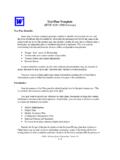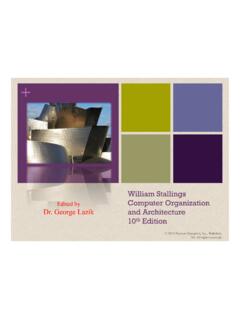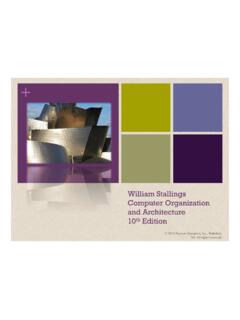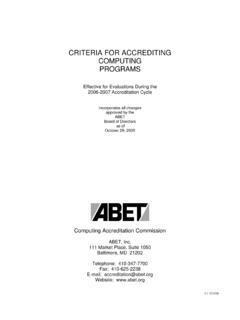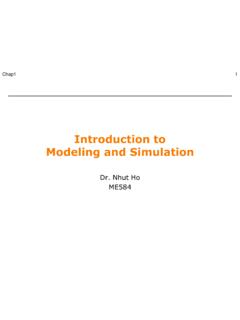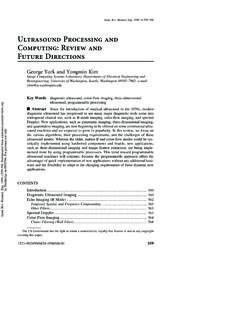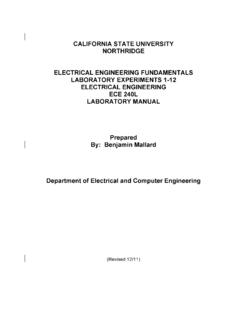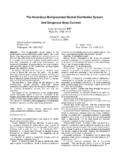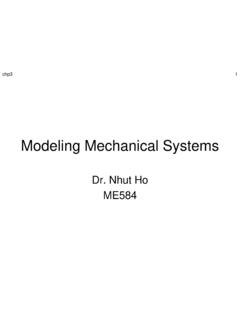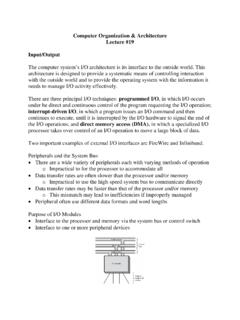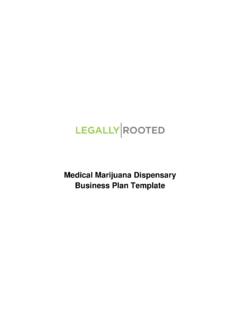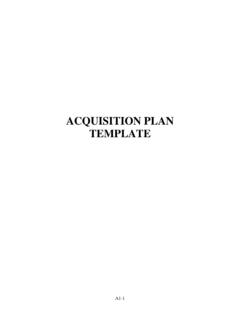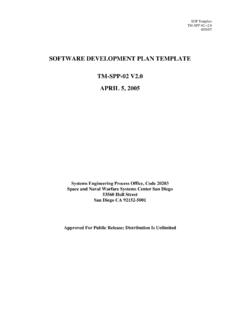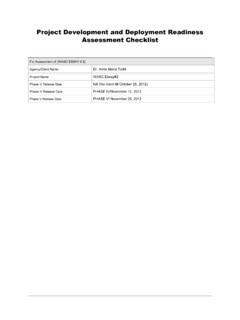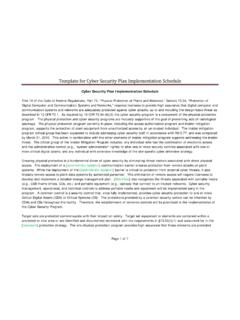Transcription of Test Plan Template (IEEE 829-1998 Format)
1 2001 - software Quality Engineering - Version A - 6 Test plan Template ( ieee 829- 1998 format ) Test plan Identifier Some type of unique company generated number to identify this test plan , its level and the level of software that it is related to. Preferably the test plan level will be the same as the related software level. The number may also identify whether the test plan is a Master plan , a Level plan , an integration plan or whichever plan level it represents. This is to assist in coordinating software and testware versions within configuration management. Unique "short" name for the test plan Version date and version number of procedure Version Author and contact information Revision history Keep in mind that test plans are like other software documentation, they are dynamic in nature and must be kept up to date. Therefore they will have revision numbers. You may want to include author and contact information including the revision history information as part of either the identifier section of as part of the introduction.
2 Introduction State the purpose of the plan , possibly identifying the level of the plan (master etc.). This is essentially the executive summary part of the plan . You may want to include any references to other plans, documents or items that contain information relevant to this project/process. If preferable, you can create a references section to contain all reference documents. Project Authorization Project plan Quality Assurance plan Configuration Management plan Relevant Policies and Standards For lower level plans, reference higher level plan (s) Identify the Scope of the plan in relation to the software Project plan that it relates to. Other items may include, resource and budget constraints, scope of the testing effort, how testing relates to other evaluation activities (Analysis & Reviews), and possible the process to 2001 - software Quality Engineering - Version A - 7 be used for change control and communication and coordination of key activities.
3 As this is the Executive Summary keep information brief and to the point. Test Items These are things you intend to test within the scope of this test plan . Essentially a list of what is to be tested. This can be developed from the software application test objectives inventories as well as other sources of documentation and information such as: Requirements Specifications Design Specifications Users Guides Operations Manuals or Guides Installation Manuals or Procedures This can be controlled and defined by your local Configuration Management (CM) process if you have one. This information includes version numbers, configuration requirements where needed, (especially if multiple versions of the product are supported). It may also include key delivery schedule issues for critical elements. Identify any critical steps required before testing can begin as well, such as how to obtain the required item. This section can be oriented to the level of the test plan .
4 For higher levels it may be by application or functional area, for lower levels it may be by program, unit, module or build. References to existing incident reports or enhancement requests should also be included. This section can also indicate items that will be excluded from testing Features To Be Tested This is a listing of what is to be tested from the USERS viewpoint of what the system does. This is not a technical description of the software but a USERS view of the functions. It is recommended to identify the test design specification associated with each feature or set of features. Set the level of risk for each feature. Use a simple rating scale such as (H, M, L); High, Medium and Low. These types of levels are understandable to a User. You should be prepared to discuss why a particular level was chosen. 2001 - software Quality Engineering - Version A - 8 This is another place where the test objectives inventories can to used to help identify the sets of objectives to be tested together, (this takes advantage of the hierarchy of test objectives).
5 Depending on the level of test plan , specific attributes (objectives) of a feature or set of features may be identified. Features Not To Be Tested This is a listing of what is NOT to be tested from both the Users viewpoint of what the system does and a configuration management/version control view. This is not a technical description of the software but a USERS view of the functions. Identify WHY the feature is not to be tested, there can be any number of reasons. Not to be included in this release of the software . Low risk, has been used before and is considered stable. Will be released but not tested or documented as a functional part of the release of this version of the software . Approach This is your overall test strategy for this test plan ; it should be appropriate to the level of the plan (master, acceptance, etc.) and should be in agreement with all higher and lower levels of plans. Overall rules and processes should be identified.
6 Are any special tools to be used and what are they? Will the tool require special training? What metrics will be collected? Which level is each metric to be collected at? How is Configuration Management to be handled? How many different configurations will be tested Hardware software Combinations of HW, SW and other vendor packages What are the regression test rules? How much will be done and how much at each test level. Will regression testing be based on severity of defects detected? How will elements in the requirements and design that do not make sense or are untestable be processed? If this is a master test plan the overall project testing approach and coverage requirements must also be identified. Specify if there are special requirements for the testing. Only the full component will be tested. A specified segment of grouping of features/components must be tested together. 2001 - software Quality Engineering - Version A - 9 Other information that may be useful in setting the approach are: MTBF, Mean Time Between Failures - if this is a valid measurement for the test involved and if the data is available.
7 SRE, software Reliability Engineering - if this methodology is in use and if the information is available. How will meetings and other organizational processes be handled. Are there any significant constraints to testing. Resource availability Deadlines Are there any recommended testing techniques that should be used, if so why? Item Pass/Fail Criteria What are the Completion criteria for this plan ? This is a critical aspect of any test plan and should be appropriate to the level of the plan . The goal is to identify whether or not a test item has passed the test process. At the Unit test level this could be items such as: All test cases completed. A specified percentage of cases completed with a percentage containing some number of minor defects. Code coverage tool indicates all code covered. At the Master test plan level this could be items such as: All lower level plans completed. A specified number of plans completed without errors and a percentage with minor defects.
8 This could be an individual test case level criterion or a unit level plan or it can be general functional requirements for higher level plans. What is the number and severity of defects located? Is it possible to compare this to the total number of defects? This may be impossible, as some defects are never detected. A defect is something that may cause a failure, and may be acceptable to leave in the application. A failure is the result of a defect as seen by the User, the system crashes, etc. Suspension Criteria and Resumption Requirements Know when to pause in a series of tests or possibly terminate a set of tests . Once testing is suspended how is it resumed and what are the potential impacts, ( regression tests ). If the number or type of defects reaches a point where the follow on testing has no value, it makes no sense to continue the test; you are just wasting resources. 2001 - software Quality Engineering - Version A - 10 Specify what constitutes stoppage for a test or series of tests and what is the acceptable level of defects that will allow the testing to proceed past the defects.
9 Testing after a truly fatal error will generate conditions that may be identified as defects but are in fact ghost errors caused by the earlier defects that were ignored. Test Deliverables What is to be delivered as part of this plan ? Test plan Test design specifications. Test case specifications Test procedure specifications Test item transmittal reports Test logs Test Incident Reports Test Summary reports Test Incident reports Test data can also be considered a deliverable as well as possible test tools to aid in the testing process One thing that is not a test deliverable is the software ; that is listed under test items and is delivered by development. These items need to be identified in the overall project plan as deliverables (milestones) and should have the appropriate resources assigned to them in the project tracking system. This will ensure that the test process has visibility within the overall project tracking process and that the test tasks to create these deliverables are started at the appropriate time.
10 Any dependencies between these deliverables and their related software deliverable should be identified. If the predecessor document is incomplete or unstable the test products will suffer as well. Test Tasks There should be tasks identified for each test deliverable. Include all inter-task dependencies, skill levels, etc. These tasks should also have corresponding tasks and milestones in the overall project tracking process (tool). If this is a multi-phase process or if the application is to be released in increments there may be parts of the application that this plan does not address. These areas need to be identified to avoid any confusion should defects be reported back on those future functions. 2001 - software Quality Engineering - Version A - 11 This will also allow the users and testers to avoid incomplete functions and prevent waste of resources chasing Non-defects. If the project is being developed as a multi-party process this plan may only cover a portion of the total functions/features.
